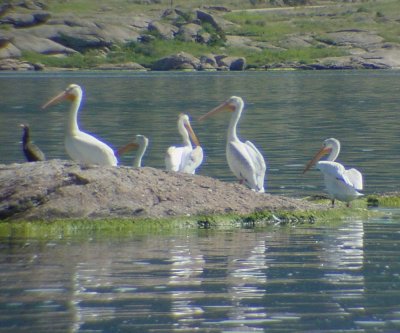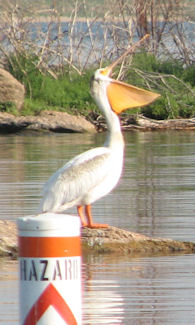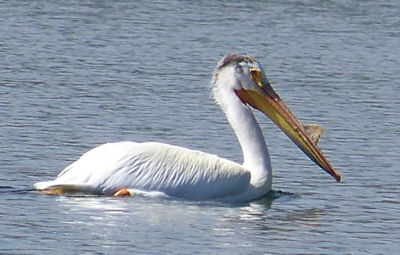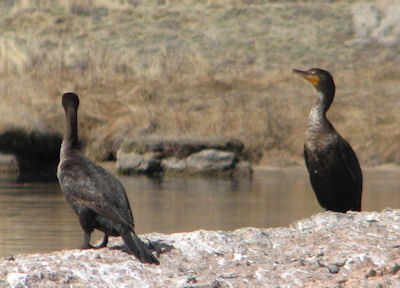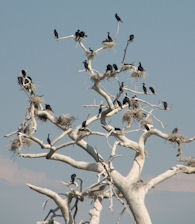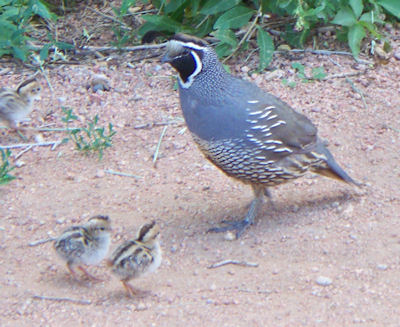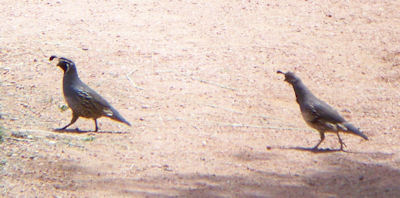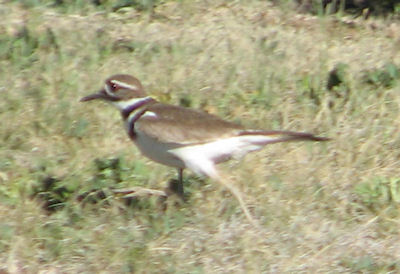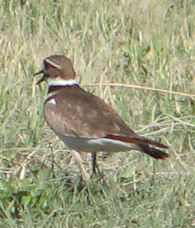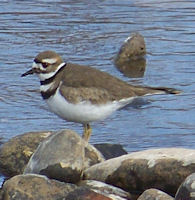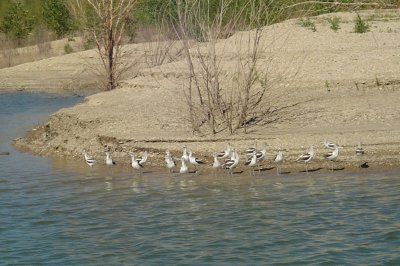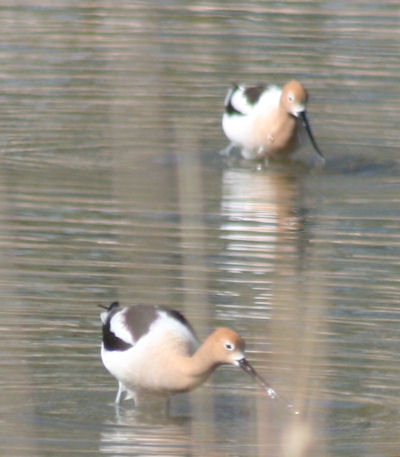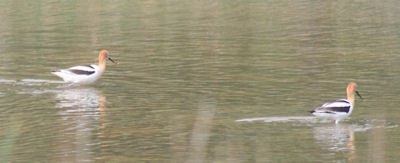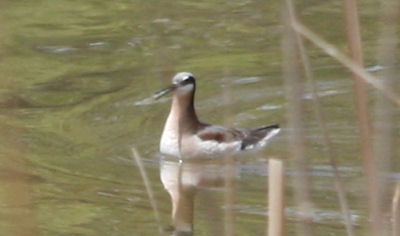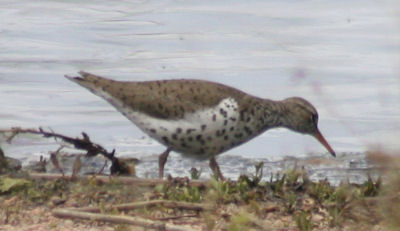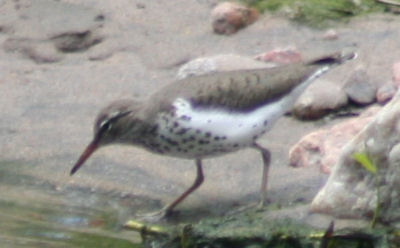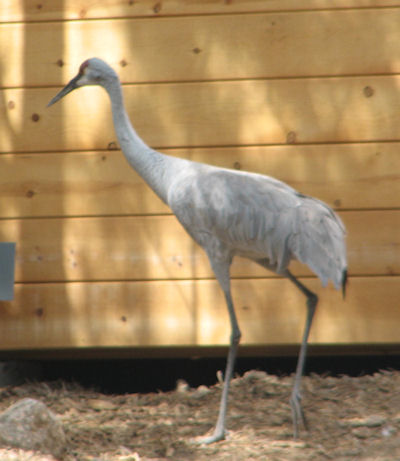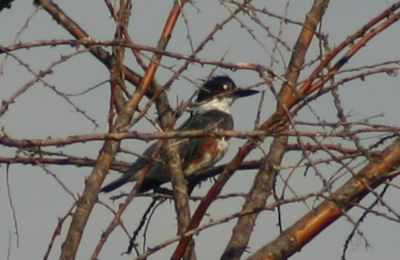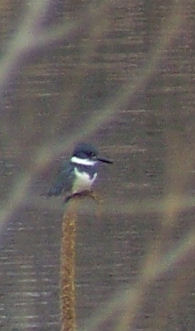| Western Grebe.
The Clark's Grebe is very similar, but has the
eye clear of the black cap, and the black stripe on the back of the neck
is narrower.
Kingdom: Animalia
Phylum: Chordata
Class: Aves
Order: Podicipediformes
Family: Podicipedidae
Genus: Aechmophorus
Species: A. occidentalis
The first picture was taken by Alyssa Erickson at Pueblo Lake in
June 2007, and clearly shows that
this is a Western Grebe, not a Clark's Grebe.
Alyssa has a much better camera than I.
The second picture was taken in April 2008, also at Pueblo.
The next two pictures show a Western Grebe eating a fish, and the mate carrying
two babies on his/her back.
These pictures were taken on Eleven Mile lake, near Lake George, Colorado on
17 August 2007.
Western Grebe:
www.mbr-pwrc.usgs.gov/Infocenter/i0010id.html
|
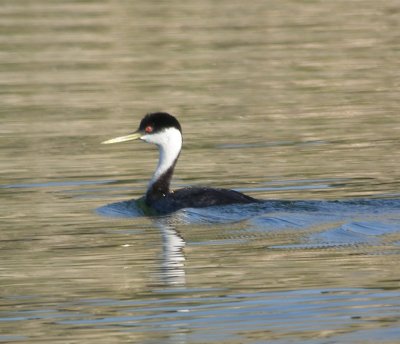
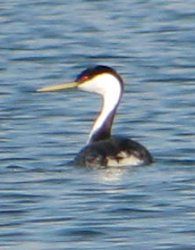

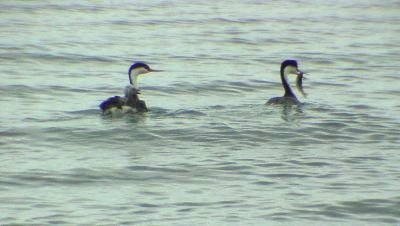
|
| Clark's Grebe, at Pueblo Lake.
Same scientific classification as the Western Grebe, except this is species Aechmophorus clarkii.
The Western Grebe is similar, but with the eye in the black area of the head.
This Clark's Grebe has the eye in the white area of the head.
This picture was taken in May 2005.
Clark's Grebe:
http://www.mbr-pwrc.usgs.gov/Infocenter/i0011id.html |

|
| A Pied-Billed Grebe, at the Fountain Creek Nature Center on 17 February 2010.
It is small, and spends lots of time diving and feeding on bottom dwellers.
Kingdom: Animalia
Phylum: Chordata
Class: Aves
Order: Podicipediformes
Family: Podicipedidae
Genus: Podilymbus
Species: P. podiceps
| 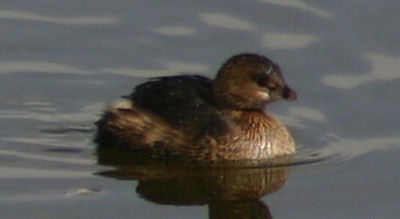

|
| A Horned Grebe, seen on 6 November 2010 at Pueblo Lake, Pueblo county CO.
It was identified by the group of birders that were with me.
The second picture seems to be of another Horned Grebe, this one at the Fountain Creek Nature Center
on 2 March 2011.
Kingdom: Animalia
Phylum: Chordata
Class: Aves
Order: Podicipediformes
Family: Podicipedidae
Genus: Podiceps
Species: P. auritus
| 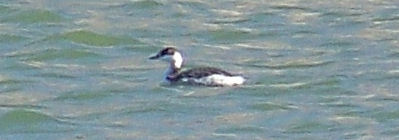

|
| An American Coot on Lake Pueblo. Fulica americana.
This picture was taken by Alyssa Erickson in June 2007.
The second picture is of a large group of Coots taken 28 September 2006 at Pueblo.
The Coot refers to any of ten species of ducklike water-dwelling
birds of the genus Fulica in the rail family, Rallidae.
Coots are found throughout the world in larger inland waters and
streams, where they swim and bob for food, mostly plants, seeds,
mollusks, and worms. Coots have greenish or bluish gray feet,
the toes of which are fringed by a lobed membrane.
When I was a kid back in North Dakota, we called them mud hens.
Kingdom: Animalia
Phylum: Chordata
Class: Aves
Order: Gruiformes
Family: Rallidae
Genus: Fulica
Species: americana
| 

|
| Another Coot, this one was looking for food with a flock
of Pigeons, near the shore of Prospect Lake in Colorado Springs,
on 26 December 2011.
| 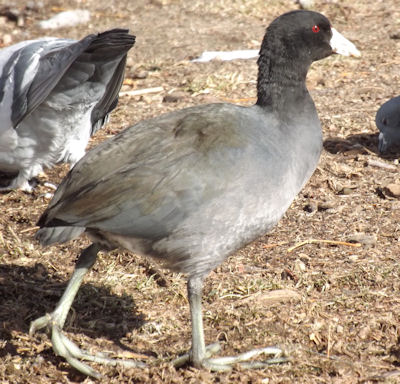
|
| This small bird is a Sora,
the most common and widely distributed rail in North America.
It kept moving rapidly checking for insects on the cattails growing out of the water,
so it was hard to get good pictures of it. It spends so much of its time
wading around in the Cattails that they are seldom seen. It rarely flies.
These photos were taken on 14 April 2010, at the Fountain Creek Nature Center.
The identification was provided by the experts at
the Colorado Birder web site.
Kingdom: Animalia
Phylum: Chordata
Class: Aves
Order: Gruiformes
Family: Rallidae
Genus: Porzana
Species: carolina ( Sora )
|
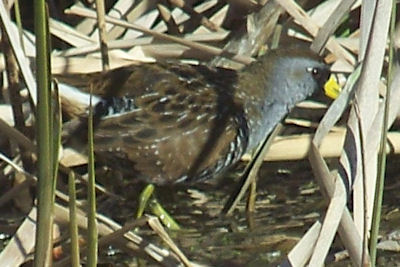
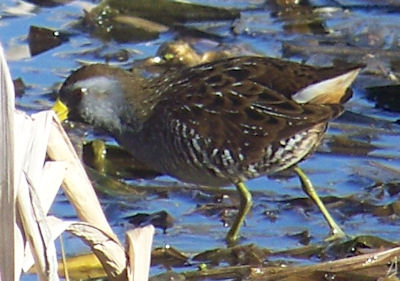
|
| This is a Virginia Rail. The picture was taken at the Fountain Creek Nature Center,
near Fountain, Colorado, on June 26, 2016. They are secretive by nature, and not often seen. For some reason, this one
was in the middle of a hiking trail, and stayed to pose for pictures until some noisy kids approached.
Kingdom: Animalia
Phylum: Chordata
Class: Aves
Order: Gruiformes
Family: Rallidae
Genus: Rallus
Species: R. limicola
|

|
| Great Blue Heron. Ardea herodias.
This was taken by Alyssa Erickson in June 2007 at Pueblo Lake, CO.
Many water birds will stand in the sun with their wings spread out to dry them,
and also to warm up in the sunshine.
Kingdom: Animalia
Phylum: Chordata
Class: Aves
Order: Ciconiiformes
Family: Ardeidae
Genus: Ardea
Species: A. herodias
The picture of the Blue Heron in flight was taken at Pueblo Lake on October 9, 2007.
The next picture was taken on 1 July 2008 at Pueblo Lake, and shows a Blue Heron nest
with a pair of young Herons, on a tree out in the water.
The fourth picture was taken on 30 May 2009 at the Fountain Creek Nature Center, Fountain Colorado.
The fifth picture was taken on 19 June 2009, at the Fountain Creek Nature Center.
This picture of the Blue Heron looking for his lunch won a Blue Ribbon at the
photo competition at the El Paso, Colorado County fair in July 2009.
This bird was standing at the edge of a pond, and finally decided that I was getting too close,
so it flew off. The next picture shows why it is named the Great Blue Heron.
Click here for more Blue Heron pictures.
Other people's photos of this bird:
www.schmoker.org/BirdPics/GBHE.html |
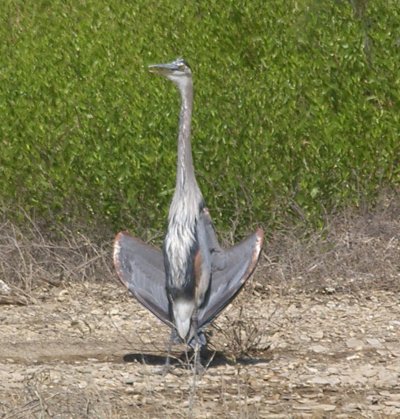
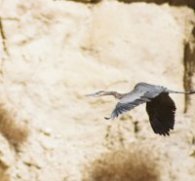

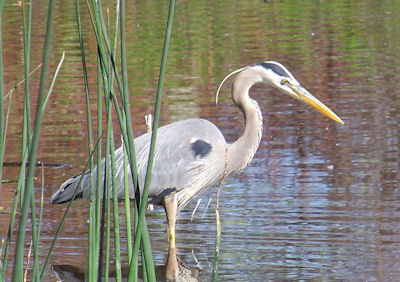
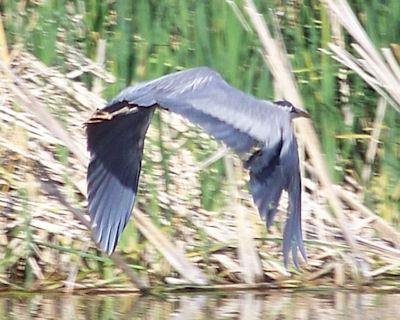
|
| Green Herons. The first and second pictures were taken on 5 September 2009 at the
Fountain Creek Nature Center.
There was a lot of luck involved with me getting these photos; luck that another photographer told me
where it was, or I wouldn't have noticed it. Luck that I was able to sneak up
on it without scaring it off.
Luck that the automatic focus on my camera focused on the bird instead of on the leaves in the
foreground.
The third was taken on 10 August 2009 at the same place.
Kingdom: Animalia
Phylum: Chordata
Class: Aves
Subclass: Neornithes
Infraclass: Neognathae
Superorder: Neoaves
Order: Ciconiiformes
Family: Ardeidae
Genus: Butorides
Species: B. virescens
| 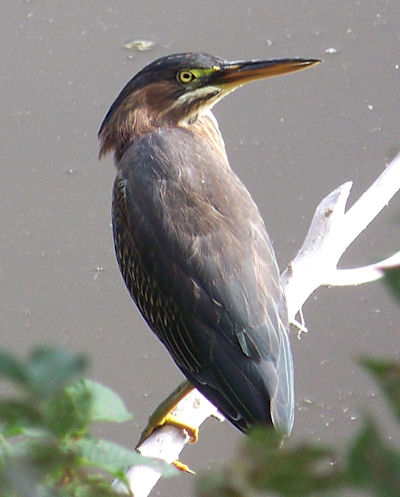
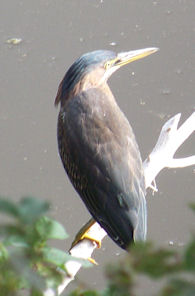
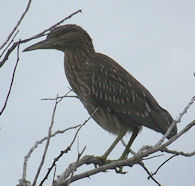
|
| A Snowy Egret. Picture taken on 23 April 2009 at the Fountain Creek Nature center.
It was about the size of a duck. According to Wikipedia: At one time, the beautiful plumes of the Snowy Egret
were in great demand by market hunters as decorations for women's hats.
This reduced the population of the species to dangerously low levels.
Now it is protected by law, under the Migratory Bird Treaty Act,
this bird's population has rebounded.
Kingdom: Animalia
Phylum: Chordata
Class: Aves
Subclass: Neornithes
Infraclass: Neognathae
Superorder: Neoaves
Order: Ciconiiformes (disputed)
Family: Ardeidae
Genus: Egretta
Species: E. thula
| 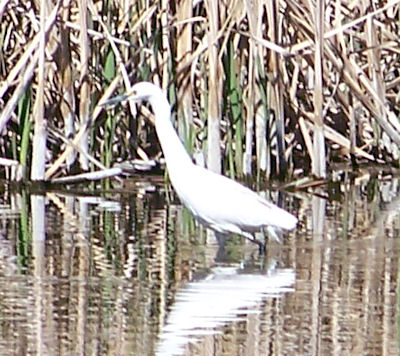

|
| A Great Egret. Picture taken on 30 May 2009 at the Fountain Creek Nature center.
It was almost the size of a Great Blue Heron.
Kingdom: Animalia
Phylum: Chordata
Class: Aves
Subclass: Neornithes
Infraclass: Neognathae
Superorder: Neoaves
Order: Ciconiiformes (disputed)
Family: Ardeidae
Genus: Ardea
Species: A. alba
| 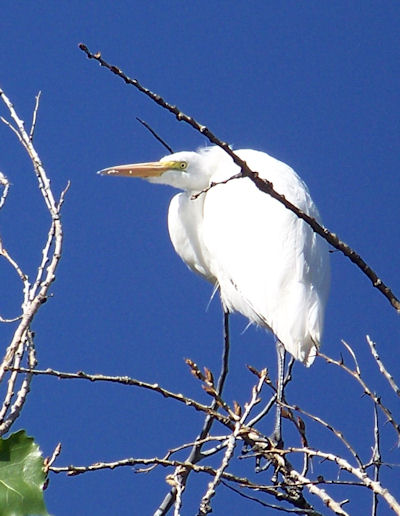
|
| Sea Gull. This Gull is probably the California Gull (Larus californicus),
which is the one that has a statue in Salt Lake city, and the same one
that followed the plows when I was a kid in North Dakota.
The Salt Lake City statue is because a large flock of these gulls saved the Mormons
from a large plague of grasshoppers in 1848.
This picture was taken on 17 August 2007 at Elevenmile Lake.
The second picture shows some juvenile California gulls, with the picture taken on 11 July 2008 at that same island
in Elevenmile Lake, Park Co., Colorado.
Scientific classification:
Kingdom: Animalia
Phylum: Chordata
Class: Aves
Order: Charadriiformes
Family: Laridae
Genus: Larus
Species: L. californicus
en.wikipedia.org/wiki/California_Gull |
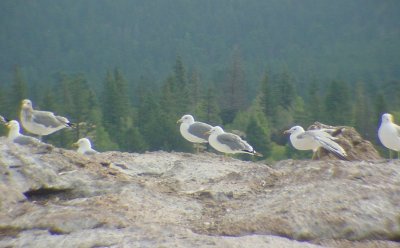

|
| California Gull (Larus californicus),
near the boat ramp at Eleven Mile Lake on 21 July 2011.
| 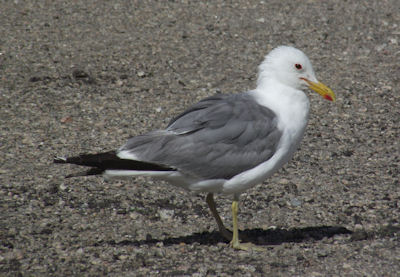
|
| This is an immature Ring-billed Gull. Larus delawarenis.
The first 3 pictures were taken at Prospect Lake, Colorado Springs,
on 29 October 2007. The next 3 were taken on 5 December 2007.
Kingdom: Animalia
Phylum: Chordata
Class: Aves
Order: Charadriiformes
Family: Laridae
Genus: Larus
Species: L. delawarensis
| 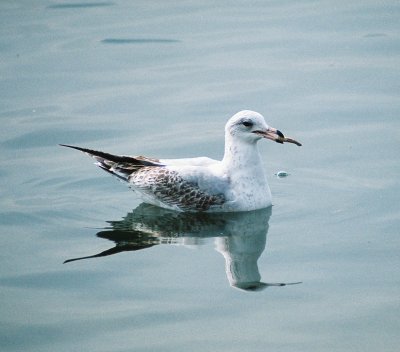
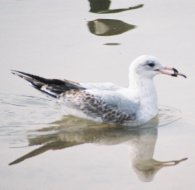
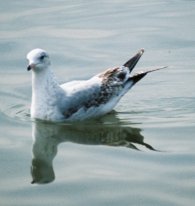
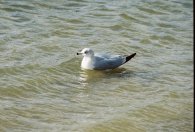
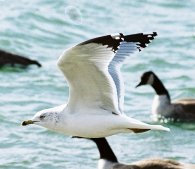

|
| An American Herring Gull. This one was photographed on 6 November 2010 at Pueblo Lake, Colorado,
It is a large gull, with characteristic black wing tips. The group of birders I was with indentified it for me.
Kingdom: Animalia
Phylum: Chordata
Class: Aves
Order: Charadriiformes
Family: Laridae
Genus: Larus
Species: L. smithsonianus
| 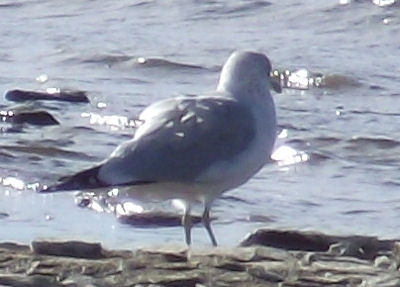

|
| A Horned owl. Picture taken at the Fountain Creek
Nature Center on 11 July 2009.
The second picture shows three young Horned Owls, still too young to leave the nest.
This picture was taken on 30 April 2010, at the Fountain Creek Regional Park.
The third picture was taken on May 6; maybe one had left the nest, or the third one
is behind the other two.
By 23 May 2010 they had all left the nest.
Thanks to
John Barry for pointing them out to me.
Kingdom: Animalia
Phylum: Chordata
Class: Aves
Order: Strigiformes
Family: Strigidae
Genus: Bubo (Horned Owls, Eagle-owls, and Fish-owls.)
Species: B. virginianus
| 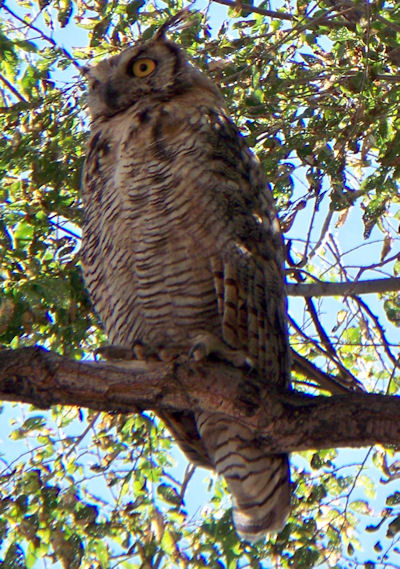
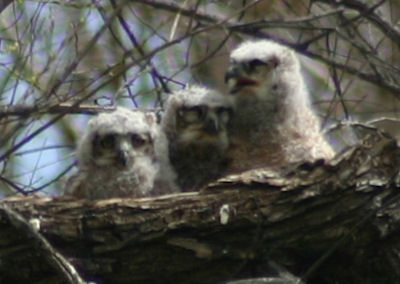
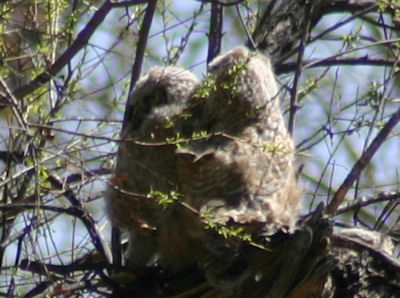
|
| The spring 2011 crop of Horned Owls. They are in the
Fountain Creek Regional Park, close to where they had the nest last year, and
even closer to the hiking trail. This picture was taken on 18 April 2011.
There is at least one more owlet in the nest.
| 
|
| A Western Screech Owl, at the Pueblo Raptor Center at Pueblo, CO on 12 February 2010.
The picture was taken through the screen on the poorly lit cage. This one has his/her ear tufts
fully erect. They have excellent camoflauge, so they are seldom seen.
Kingdom: Animalia
Phylum: Chordata
Class: Aves
Order: Strigiformes
Family: Strigidae
Genus: Megascops
Species: M. kennicottii
| 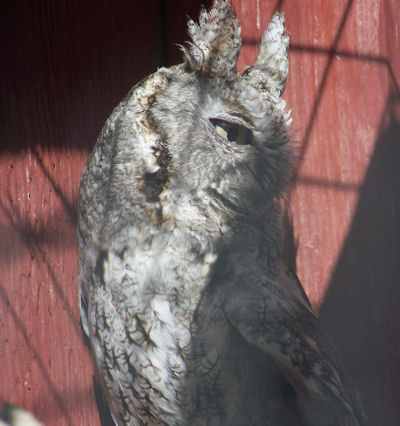
|
| Mourning Dove. According to Wikipedia,
The bird is also called the American Mourning Dove or Rain Dove,
and formerly was known as the Carolina Pigeon or Carolina Turtledove
Go to
www.youtube.com/user/don5erickson?feature=mhsn#p/a/u/1/NukTI98KVn0 for a video taken on 9 May 2011 in Colorado Springs.
Kingdom: Animalia
Phylum: Chordata
Class: Aves
Order: Columbiformes
Family: Columbidae
Genus: Zenaida
Species: Z. macroura
| 
|
| A Eurasian Collared Dove.
This Picture was taken in Colorado Springs, Colorado on 16 June 2008.
This Dove is originally from Southeastern Europe. According to Wikipedia,
it was introduced into the Bahamas in the 1970s and spread to Florida by 1982.
Now, it is in most of North America.
It has a call that sounds like Morse code for the letter "r" ( .-. ) (di-dah-dit).
Go to
www.youtube.com/watch?v=eHLBmGu-6hk for a video taken on 11 May 2011 in Colorado Springs.
Kingdom: Animalia
Phylum: Chordata
Class: Aves
Order: Columbiformes
Family: Columbidae
Genus: Streptopelia
Species: S. decaocto
| 
|
| Rock Pigeon. This picture was taken in
Colorado Springs CO May 5, 2008.
This bird is not native to Colorado. It is a Eurasian species, introduced in Nova Scotia in 1606,
and it quickly spread across North America. (ref. the rticle "Alien Invasion" by Mary Taylor Young, in
the July/August 2010 issue of the Colorado Outdoors magazine.)
Kingdom: Animalia
Phylum: Chordata
Class: Aves
Order: Columbiformes
Family: Columbidae
Genus: Columba
Species: C. livia
| 

|
| On 21 March 2011, a Homing Pigeon joined our flock of wild Rock Pigeons in Colorado Springs. Articles found on
the internet say that wild flocks will sometimes take in a stray homing pigeon that is not quite smart enough
to find its way back home. It is a domestic pigeon, descended from Rock Pigeons.
| 
|
A Woodpecker working on a Red Maple tree in our side yard.
This one is a male Red-shafted Northern Flicker.
The picture was taken on 15 April 2005.
The second picture, sitting on a fence post, was taken 1 November 2004.
The third picture was taken at Prospect Lake, 29 October 2007.
The male is identified by the red mark starting at the base of the beak.
The fourth picture with two females was taken 28 June 2009 in Colorado Springs, CO
This sound is often heard in the spring.
Kingdom: Animalia
Phylum: Chordata
Class: Aves
Order: Piciformes
Family: Picidae
Genus: Colaptes
Species: C. auratus
| 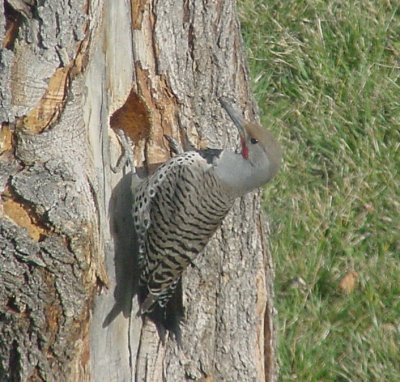


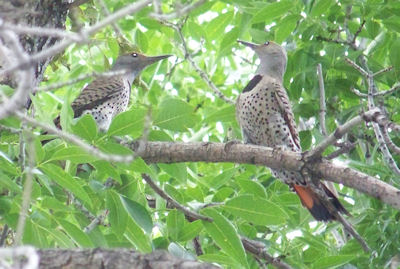
|
| This picture is a close-up of a female, taken on 12 February 2011. Normally, they do not come to
the bird feeder, but this one made an exception for the suet.
| 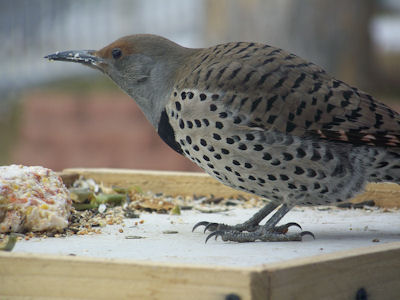 |
| This female Northern Flicker was at my bird
feeder with a deformed bill, on 23 March 2011.
She probably has trouble feeding, and certainly would not be able to
make holes in trees.
But, she is able to handle the suet at my bird feeder.
Both I and my neighbor saw one last year with a bill that was even more deformed than this one.
This woodpecker is on Youtube.com at
www.youtube.com/watch?v=OolvnN7mv1s so you can see her difficulty eating.
She comes back almost every day.
|
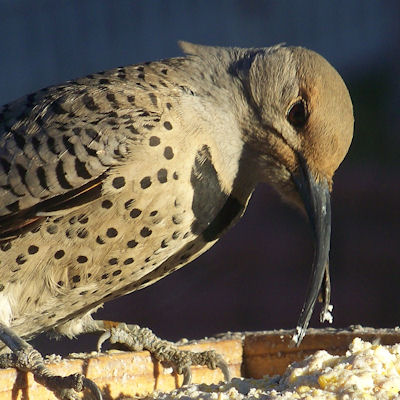 |
| These pictures show a Downy Woodpecker, found at the Fountain Creek Nature Center,
on 30 December 2010.
The Hairy Woodpecker ( P. villosus ) also looks like this,
but has a longer bill.
Kingdom: Animalia
Phylum: Chordata
Class: Aves
Order: Piciformes
Family: Picidae
Genus: Picoides
Species: P. pubescens
| 
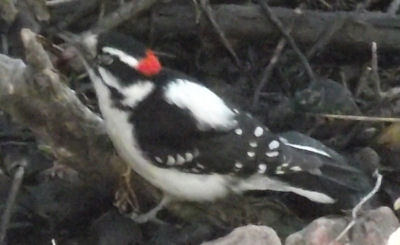
|
| Another Downy Woodpecker, found at the Fountain Creek Nature Center
on 26 December 2011. This one is a female, since she does not have
the red mark on the back of her head. Again, the Hairy Woodpecker
looks like this, but has a longer bill.
| 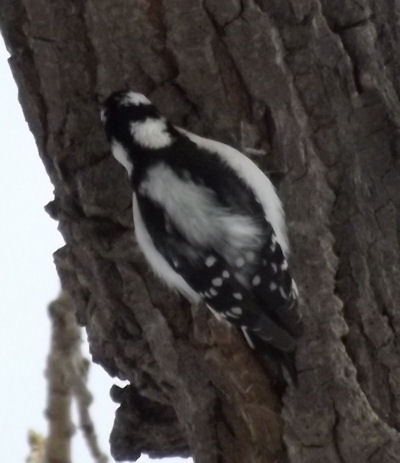
|
| Another Downy Woodpecker, this one at my front yard in Colorado Springs on 20 April 2014.
Again, the Hairy Woodpecker
looks like this, but has a longer bill. I still do not have a good picture to look at bill length,
but I think this is the shorter version, which makes it a Downy woodpecker.
| 
|
| This is a Lewis's Woodpecker that stopped by my bird feeder on September 30, 2017.
Kingdom: Animalia
Phylum: Chordata
Class: Aves
Order: Piciformes
Family: Picidae
Genus: Melanerpes
Species: M. lewis
| 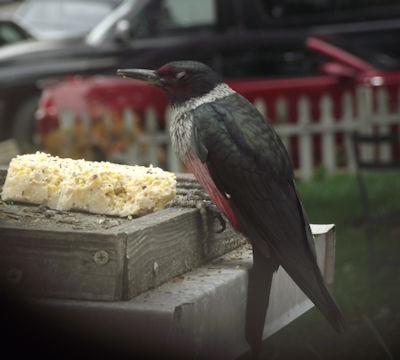
|
| A female Rufous Hummingbird, at the Bear Creek Nature Center, on the west side of Colorado Springs, CO
on 1 September 2009. The male of this species is slightly smaller, and has a different
color pattern.
Kingdom: Animalia
Phylum: Chordata
Class: Aves
Subclass: Neornithes
Infraclass: Neognathae
Order: Apodiformes
Family: Trochilidae
Genus: Selasphorus
Species: S. rufus
| 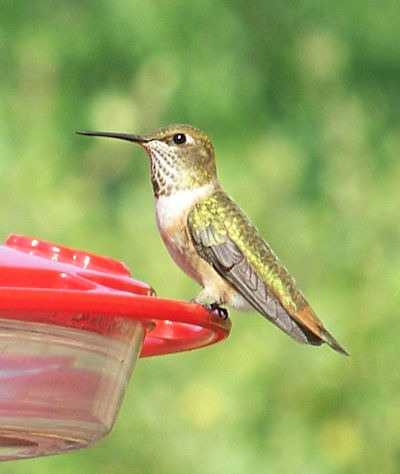
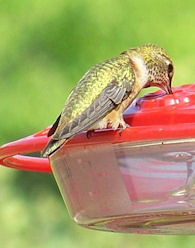
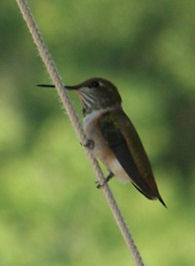
|
| Another one found at the Bear Creek Nature Center in the west side of Colorado Springs
on 1 September 2012. People at the Colorado Birder web site think that this is a Rufous, maybe a
female or juvenile. This one let me get fairly close, and posed
for pictures.
| 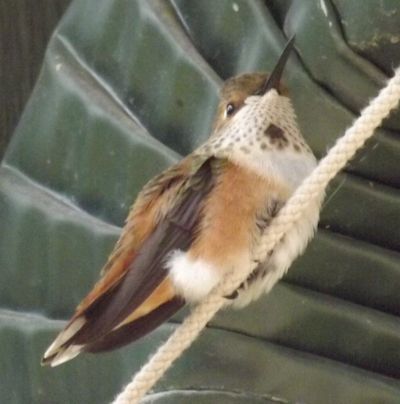
|
| This appears to be a female Black-chinned hummingbird.
It was found at the Bear Creek Nature Center in the west side of Colorado Springs
on 22 May 2011. That species is reported to be common at this locaation.
There were two hummingbirds flying back and forth in some brush,
and when I approached, this one perched on a branch, and I could not
see where the other one went to. It was a very small bird.
Kingdom: Animalia
Phylum: Chordata
Class: Aves
Order: Apodiformes[1]
Family: Trochilidae
Genus: Archilochus
Species: A. alexandri
| 
|
| This appears to be a male Black-chinned hummingbird.
It was found at the Bear Creek Nature Center in the west side of Colorado Springs
on 22 May 2011.
Kingdom: Animalia
Phylum: Chordata
Class: Aves
Order: Apodiformes[1]
Family: Trochilidae
Genus: Archilochus
Species: A. alexandri
| 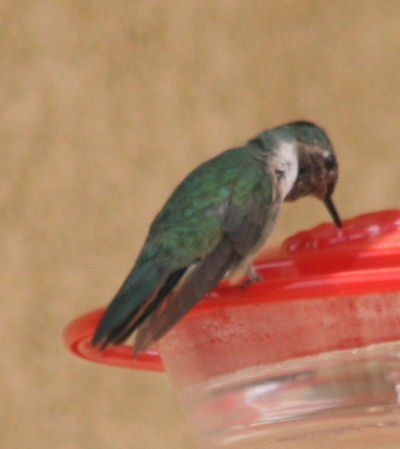
|
| This one was at the Bear Creek Nature Center on 5 August 2010.
It is probably another Black-chinned hummingbird, but not for sure.
| 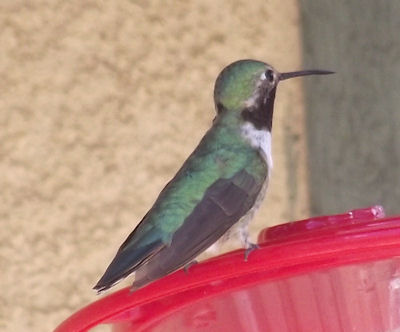
|
| This looks like a female Black-chinned hummingbird.
It also looks like
the pictures of the female Ruby-throated hummingbird, but I don't think
that species comes to Colorado.
Seen at the Bear Creek Nature Center, Colorado Springs, on 6 August 2011.
| 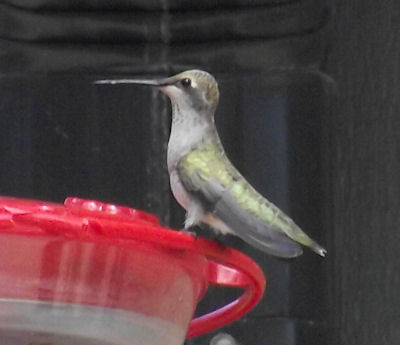
|
| I think that these are Broad-tailed hummingbirds, based
on the color pattern I see in the tail.
They also seem to be just females.
The first picture was taken
on 11 August 2011 at the Bear Creek Nature Center in Colorado Springs,
and the next two at the same place on 28 August.
Kingdom: Animalia
Phylum: Chordata
Class: Aves
(unranked): Cypselomorphae
Order: Apodiformes
Family: Trochilidae
Subfamily: Trochilinae
Genus: Selasphorus
Species: S. platycercus
| 
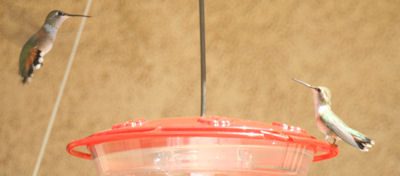
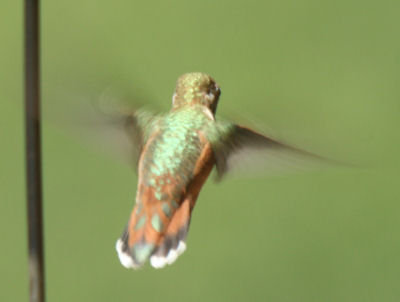
|
| On 11 August 2011, at the Bear Creek Nature Center in Colorado
Springs, CO, the Hummingbirds were plentiful, and I was fortunate enough to get
a photo of this nest. Very hard to find.
| 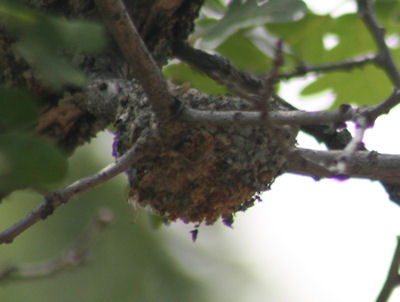
|
| A Turkey Vulture, AKA Turkey Buzzard or just Buzzard. The first picture was taken by
Alyssa Erickson.
The second and third pictures are interesting. The second picture was taken on 6 August 2008, while the buzzard was circling
over Colorado Springs looking for any dead animals it might find in back yards.
The third picture was taken almost 8 years later, this time at Skaguay Lake on July 7, 2016. In both cases,
when I took the pictures, I thought that the difference in color of the left wing was due to the way the
sunlight was shining. But when I look at the most recent one, I am starting to think that we have a buzzard
in Colorado that has a left wing much lighter in color than the right wing.
The fourth was taken on 29 August 2008 at Elevenmile Lake.
The fifth was taken near Elevenmile Lake on 9 September 2008. They have
some animal on the ground. The face on that animal looks like a Badger.
Kingdom: Animalia
Phylum: Chordata
Class: Aves
Order: Ciconiiformes
Family: Cathartidae
Genus: Cathartes
Species: C. aura
| 
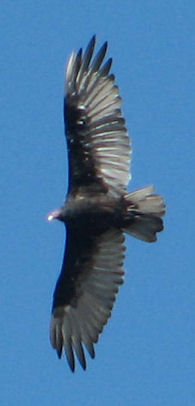


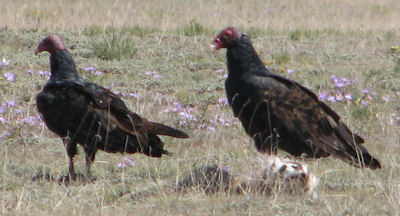
|
| A Turkey Vulture near Brush Hollow reservoir,
Fremont county, Colorado on 4 June 2010.
A Prairie Dog had been run over on the road, and this bird was staying close to it.
As a result, I was close enough for a good photo.
| 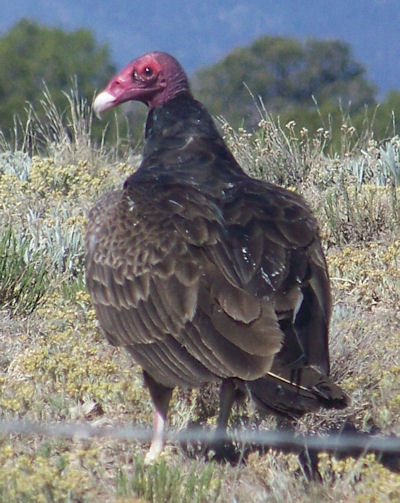
|
| A Peregrene Falcon, at the Pueblo Raptor Center at Pueblo, CO on 12 February 2010.
The picture was taken through the screen on the poorly lit cage. This bird had been at the
Air Force Academy at one time.
Kingdom: Animalia
Phylum: Chordata
Class: Aves
Order: Falconiformes
Family: Falconidae
Genus: Falco
Species: F. peregrinus
| 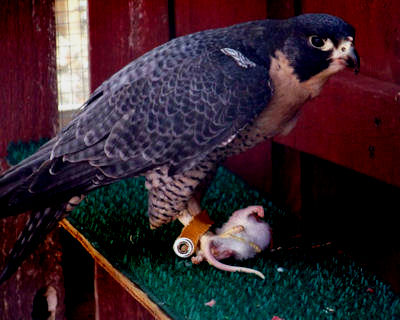
|
| A Prairie Falcon, at the Pueblo Raptor Center at Pueblo, CO on 12 February 2010.
The picture was taken through the screen on the poorly lit cage. This bird had also been at the
Air Force Academy at one time.
Kingdom: Animalia
Phylum: Chordata
Class: Aves
Order: Falconiformes
Family: Falconidae
Genus: Falco
Species: F. mexicanus
| 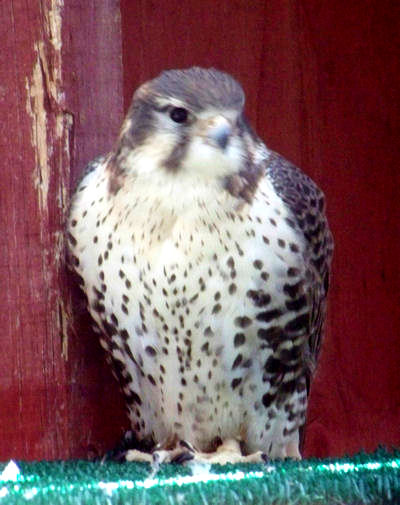
|
| Another Prairie Falcon, found on September 11, 2014, in rural Elbert County, Colorado.
| 
|
| An American Kestrel, at the Pueblo Raptor Center at Pueblo, CO on 12 February 2010.
The picture was taken through the screen on the poorly lit cage. This is the smallest
falcon, not much bigger than a robin.
Kingdom: Animalia
Phylum: Chordata
Class: Aves
Order: Falconiformes
Family: Falconidae
Genus: Falco
Species: F. sparverius
| 
|
| Golden Eagles, at the Pueblo Raptor Center at Pueblo, CO on 12 February 2010.
The picture was taken through the screen on the poorly lit cage.
Kingdom: Animalia
Phylum: Chordata
Class: Aves
Order: Accipitriformes (or Falconiformes, q.v.)
Family: Accipitridae
Genus: Aquila
Species: chrysaetos
| 
|
| A Bald Eagle, at the Pueblo Raptor Center at Pueblo,
CO on 12 February 2010.
The picture was taken through the screen on the poorly lit cage.
The second picture was taken on the same day, just north of Pueblo Lake. There were
several of them flying circles, but not close enough for good pictures. These Eagles
often spend the winter at Pueblo Lake, then return further north in the spring.
They usually nest in the northern part of Colorado.
Here is some
live video of a nesting Bald Eagle in Iowa.
Kingdom: Animalia
Phylum: Chordata
Class: Aves
Order: Accipitriformes
Family: Accipitridae
Genus: Haliaeetus
Species: H. leucocephalus
| 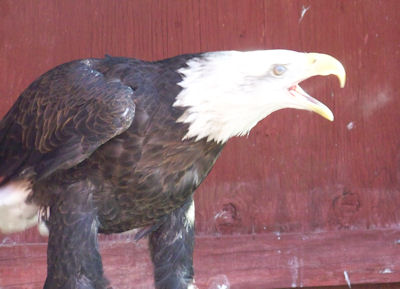
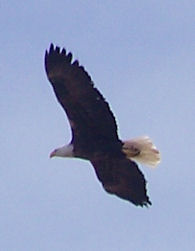
|
| Another Bald Eagle, this one near the intersection of
Teller county roads 1 and 11, Teller county Colorado. Photo taken 22 May 2012.
| 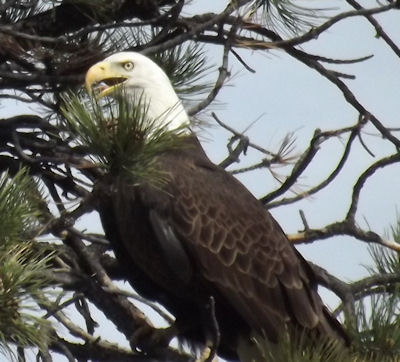
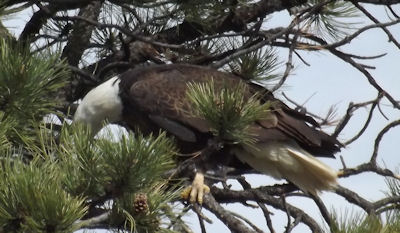
|
| Red-Tailed Hawks. The first two pictures were taken in Elbert Co., Colorado on 11 August 2008.
The "comma, dash, dash, comma" pattern on the leading edge of the wing is a distinguishing feature
of the Red-Tailed hawk.
The third and fourth pictures were taken in Eastern El Paso county on 17 March 2010.
Here is some
live video of a nesting pair of Red-Tail hawks at Cornell University in New York.
Here is a link to Youtube
www.youtube.com/watch?v=33DWqRyAAUw for a screaming Red-Tailed Hawk.
Click here for more Red-tail hawk pictures.
Kingdom: Animalia
Phylum: Chordata
Class: Aves
Order: Falconiformes
Family: Accipitridae
Genus: Buteo
Species: B. jamaicensis
| 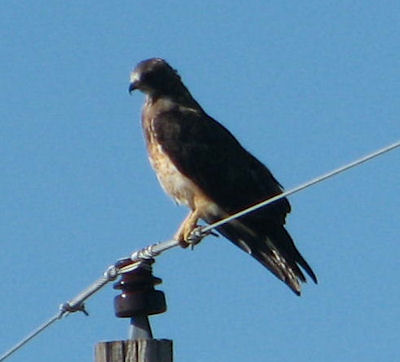
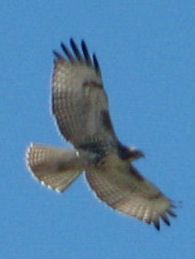
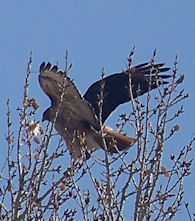

|
| Another Red-Tailed Hawk, watching the
prairie for any movement of a possible meal. This was in Elbert county
Colorado on 13 September 2011.
| 
|
|
A Ferruginous Hawk, found in rural Elbert county, Colorado on 28 September 2010.
Kingdom: Animalia
Phylum: Chordata
Class: Aves
Order: Falconiformes (or Accipitriformes)
Family: Accipitridae
Genus: Buteo
Species: B. regalis
| 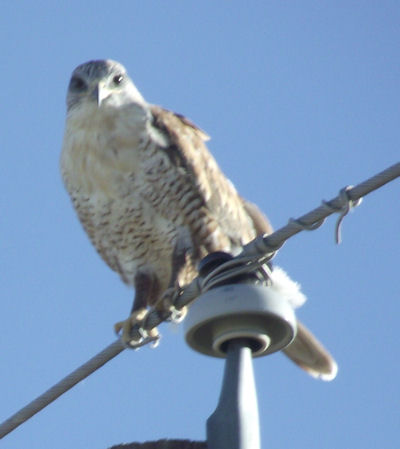
|
This is a Cooper's Hawk, part of the Accipiter Genus.
These are called Bird Hawks, and have long tails.
Found at the Fountain Creek Nature Center on 20 August 2009.
This one looks like some photos of a Juvenile Cooper's hawk seen on the internet.
It is also a nice match to a photo of a Cooper's Hawk on
the Colorado Birder web site at
coloradobirder.ning.com/photo/coopers-hawk .
It seems to have a very long and flexible neck.
Kingdom: Animalia
Phylum: Chordata
Class: Aves
Order: Falconiformes (or Accipitriformes, q.v.)
Family: Accipitridae
Genus: Accipiter (Bird Hawks)
Species: A. cooperii
| 
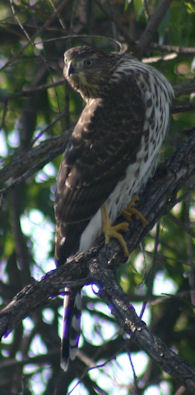
|
| Another Cooper's Hawk. This one visited my front yard
on 29 October 2011. It seemed to think that it had seen something
that looked like a meal. I think it is a juvenile. It started on
my fence, and then moved to my mailbox.
| 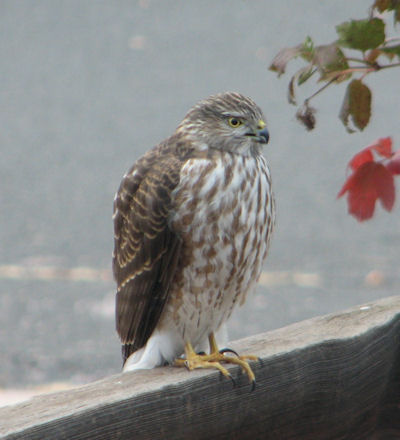
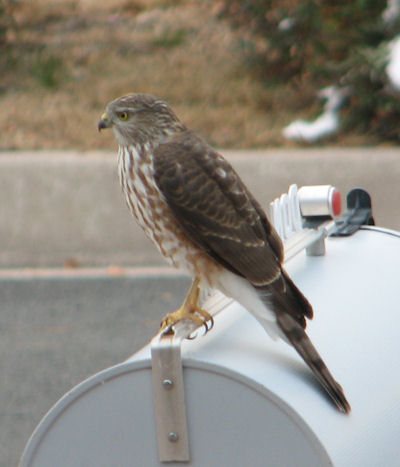
|
| This Cooper's Hawk came by my front yard on 23 September 2013,
trying to catch some Sparrows that were at my bird feeder.
| 
|
| A Swainson's Hawk, at the Pueblo Raptor Center at Pueblo,
CO on 12 February 2010.
Kingdom: Animalia
Phylum: Chordata
Class: Aves
Subclass: Neornithes
Infraclass: Neognathae
Superorder: Neoaves
Order: Falconiformes
Family: Accipitridae
Genus: Buteo
Species: B. swainsoni
| 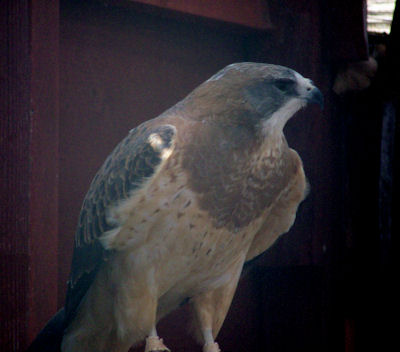
|
| Another Swainson's Hawk. Found in the northern part of El Paso County
Colorado on 10 August 2010, near Ramah, Colorado.
At first, I thought it was a Redtail Hawk, since that is what we normally find in rural
Colorado. The experts at the Colorado Birder web site corrected me.
Normally, a Redtail Hawk will leave
their perch if your car stops or even slows down, but a Swainson's Hawk
will often stay and pose for pictures, like this one did.
This one stayed put even when I leaned out the drivers window to take it's photo.
| 
|
| An Osprey. They are large raptors.
This one was found at Lake Pueblo on 18 September 2008. They are also called Fish Hawks or Sea Hawks.
Some specialists say that this species should be divided into four sub-species, and if so, this one is
the sub-species P. h. carolinensis, found in North America.
Look at this site for some
live video of an Osprey nest near Longmont, CO.
Kingdom: Animalia
Phylum: Chordata
Class: Aves
Order: Falconiformes
Family: Pandionidae
Genus: Pandion
Species: P. haliaetus
| 
|
| This Osprey was found in a large nest on the south side of
Brush Hollow reservoir, in Fremont county Colorado on 21 May 2010.
When I approached, three Great Blue Herons in a tree close by left.
The people on the Colorado Birder web page identified it for me.
This is an adult, sitting on eggs, which is why it didn't leave.
These nesting sites are built specially for the Ospreys.
I wonder why the Great Blue Herons were there; maybe they were waiting for the
Osprey to leave the nest, so they could eat the eggs? Would Great Blue Herons do that?
I don't know, but it wouldn't surprise me.
These pictures were taken with my Fujifilm FinePix S1000fd camera.
|
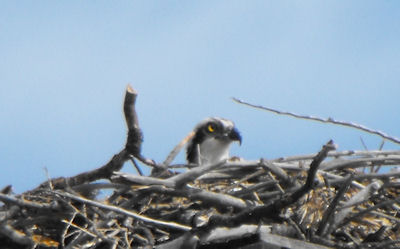
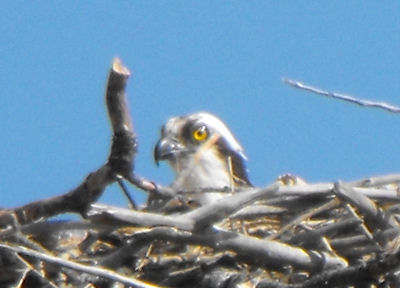
|
| A return trip to Brush Hollow was taken on 28 May 2010.
Everything looked the same, except this time both Ospreys were present.
I presume that once the eggs hatch, the adults will stay busy bringing meals to the
youngsters.
Another return trip was made on 4 June 2010. No changes were obvious.
The bird on the nest stood up and did something with the eggs, probably
turning them, and then sat on them again. Only the one Osprey was seen.
Another return trip on 10 June, no changes.
Another return trip on 17 June. Mama was sitting on the nest. When
I got out of the car, she stood up. After a while, she flew off.
So I still don't know if the eggs had hatched.
Later weekly return trips found no activity at the nest.
Two return trips in the spring of 2011 and 2012 showed no activity. The water in Brush Hollow
was very low; maybe they are emptying the reservoir.
|
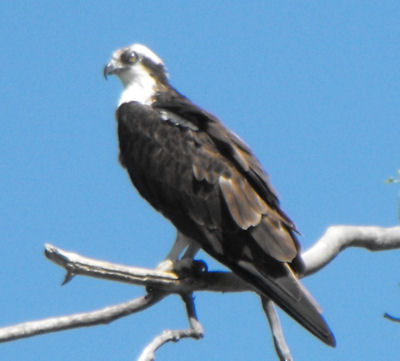
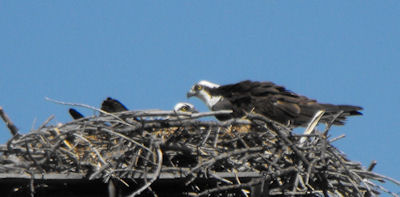
|
| Wild Turkeys, (Meleagris gallopavo) at the Air Force Academy on
30 October 2007. The third picture was taken near Ramah, Colorado on 2 November 2006,
and the fourth picture was taken there on 29 May 2009, and includes six newly hatched
turkeys.
The last picture was taken on 28 September 2010 at Ramah, El Paso county, Colorado.
The turkeys at the Air Force Academy are probably the Merriam's subspecies, which are native to Colorado, but found
in the foothills and mountains. Those found at Ramah are probably the Rio Grande subspecies, which were introduced
to the eastern plains of Colorado.
Kingdom: Animalia
Phylum: Chordata
Class: Aves
Order: Galliformes
Family: Meleagrididae
Genus: Meleagris
Species: M. gallopavo
and there are several sub-species, with subtle differences.
| 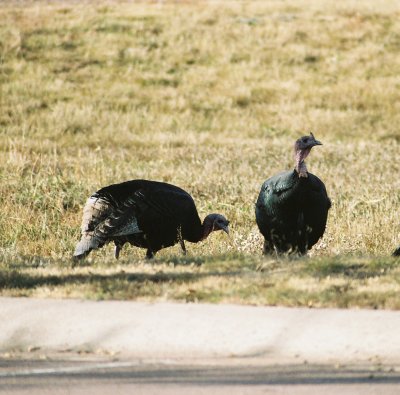
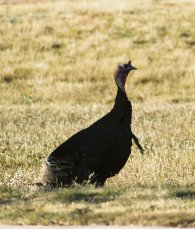
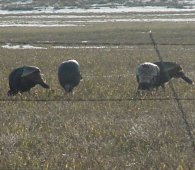
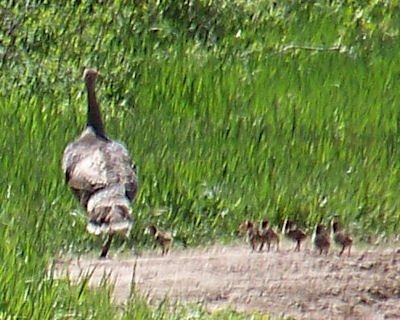
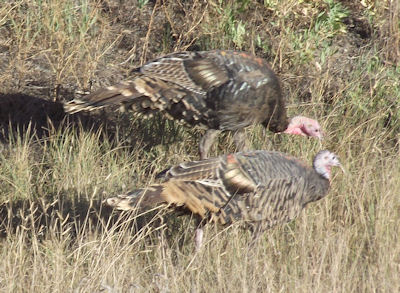
|
| Pictures of the Ramah flock, 7 November 2014. There
seems to be about 10 turkeys in the flock this year.
| 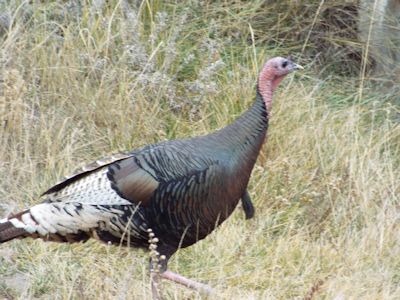
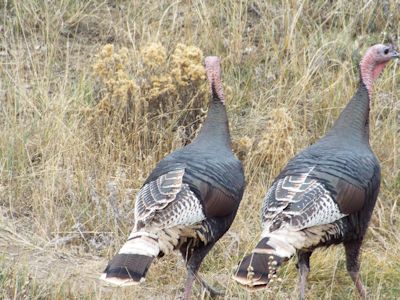
|
| May 9, 2016, near Ramah, Colorado.
This Tom is all decked out and strutting around in his finest courtship fashion,
but the hen does not seem too interested so far.
I saw only 5 or 6 birds on this day. The flock may be smaller than two years ago.
| 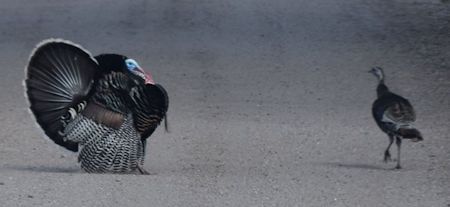
|
